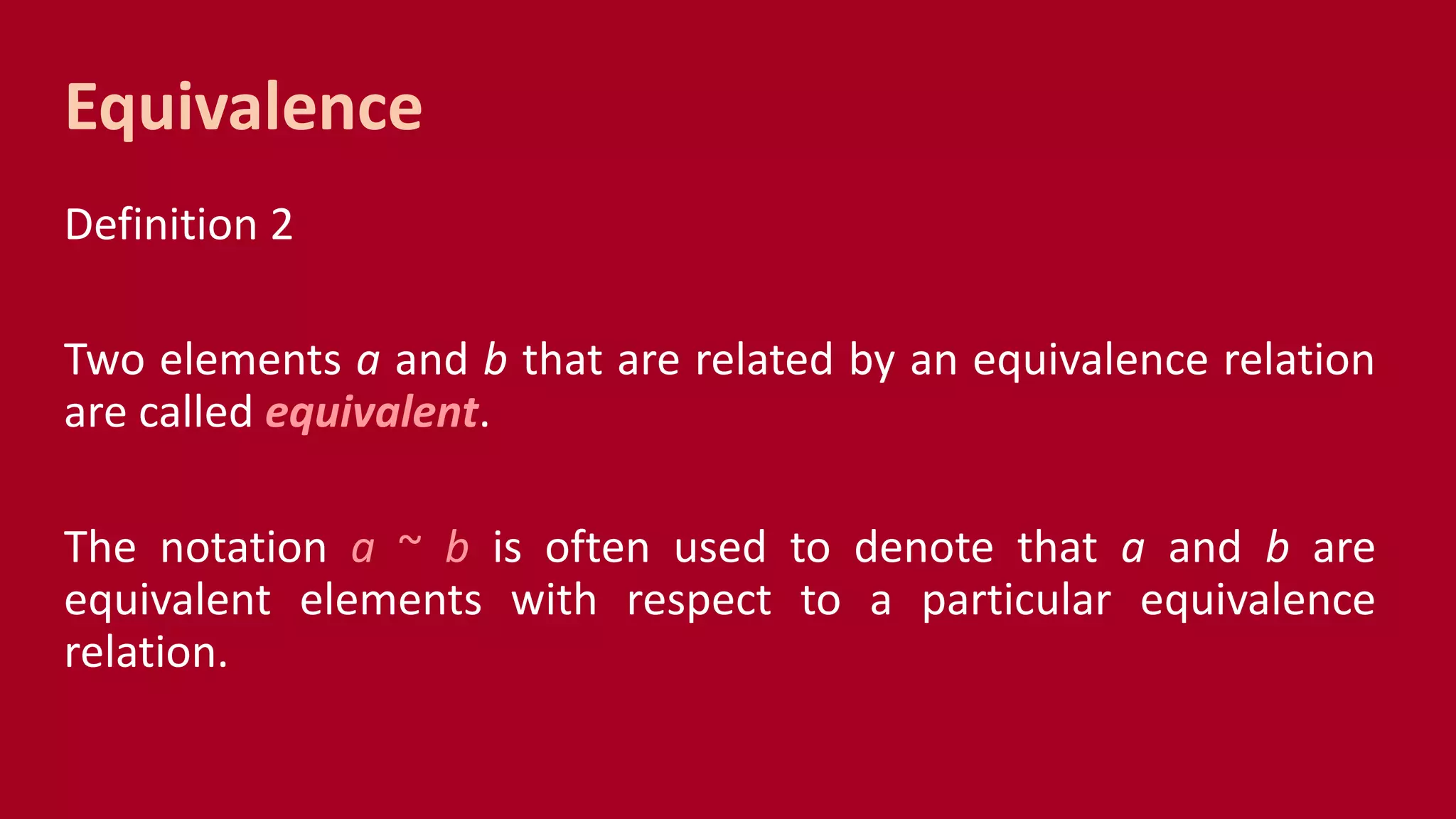This document discusses equivalence relations and partial orderings, defining key concepts such as reflexivity, symmetry, and transitivity. It provides examples of equivalence relations and their classes, as well as the characteristics of partial orderings and posets, including definitions of comparable and incomparable elements. Additionally, it outlines the process of creating Hasse diagrams to represent partial orderings.














![Equivalence Class
Definition 3
Let R be an equivalence relation on a set A. The set of all elements
that are related to an element a of A is called the equivalence
class of a.
The equivalence class of a with respect to R is denoted by [a]R.
When only one relation is under consideration, we can delete the
subscript R and write [a] for this equivalence class.](https://image.slidesharecdn.com/cmsc56lec16-190425085324/75/CMSC-56-Lecture-16-Equivalence-of-Relations-Partial-Ordering-15-2048.jpg)
![Equivalence Class
In other words, if R is an equivalence relation on a set A, the
equivalence class of the element a is [a]R = { b | (a, b) ∈ R }.
If b ∈ [a]R, then b is called a representative of this equivalence
class](https://image.slidesharecdn.com/cmsc56lec16-190425085324/75/CMSC-56-Lecture-16-Equivalence-of-Relations-Partial-Ordering-16-2048.jpg)
![Example
Given the equivalence relation R = {(1,1), (1,2), (1,3), (2,1), (2,2),
(2,3), (3,1), (3,2), (3,3), (4,4), (5,5)} on set {1, 2, 3, 4, 5}.
Find [1], [2], [3], [4], and [5].](https://image.slidesharecdn.com/cmsc56lec16-190425085324/75/CMSC-56-Lecture-16-Equivalence-of-Relations-Partial-Ordering-17-2048.jpg)
![Solution
Given the equivalence relation R = {(1,1), (1,2), (1,3), (2,1), (2,2),
(2,3), (3,1), (3,2), (3,3), (4,4), (5,5)} on set {1, 2, 3, 4, 5}.
Find [1], [2], [3], [4], and [5].
[1] = {1, 2, 3} [4] = {4}
[2] = {1, 2, 3} [5] = {5}
[3] = {1, 2, 3}](https://image.slidesharecdn.com/cmsc56lec16-190425085324/75/CMSC-56-Lecture-16-Equivalence-of-Relations-Partial-Ordering-18-2048.jpg)

![Solution
What is the equivalence class of an integer for the equivalence
relation such that aRb if and only if a = b or a = −b?
[a] = { –a, a }.
This set contains two distinct integers unless a = 0.](https://image.slidesharecdn.com/cmsc56lec16-190425085324/75/CMSC-56-Lecture-16-Equivalence-of-Relations-Partial-Ordering-20-2048.jpg)
![Solution
What is the equivalence class of an integer for the equivalence
relation such that aRb if and only if a = b or a = −b?
[a] = { –a, a }.
This set contains two distinct integers unless a = 0.
For instance, [ 7 ] = { −7, 7 },
[−5] = {−5, 5 }, and
[0] = {0}](https://image.slidesharecdn.com/cmsc56lec16-190425085324/75/CMSC-56-Lecture-16-Equivalence-of-Relations-Partial-Ordering-21-2048.jpg)



















